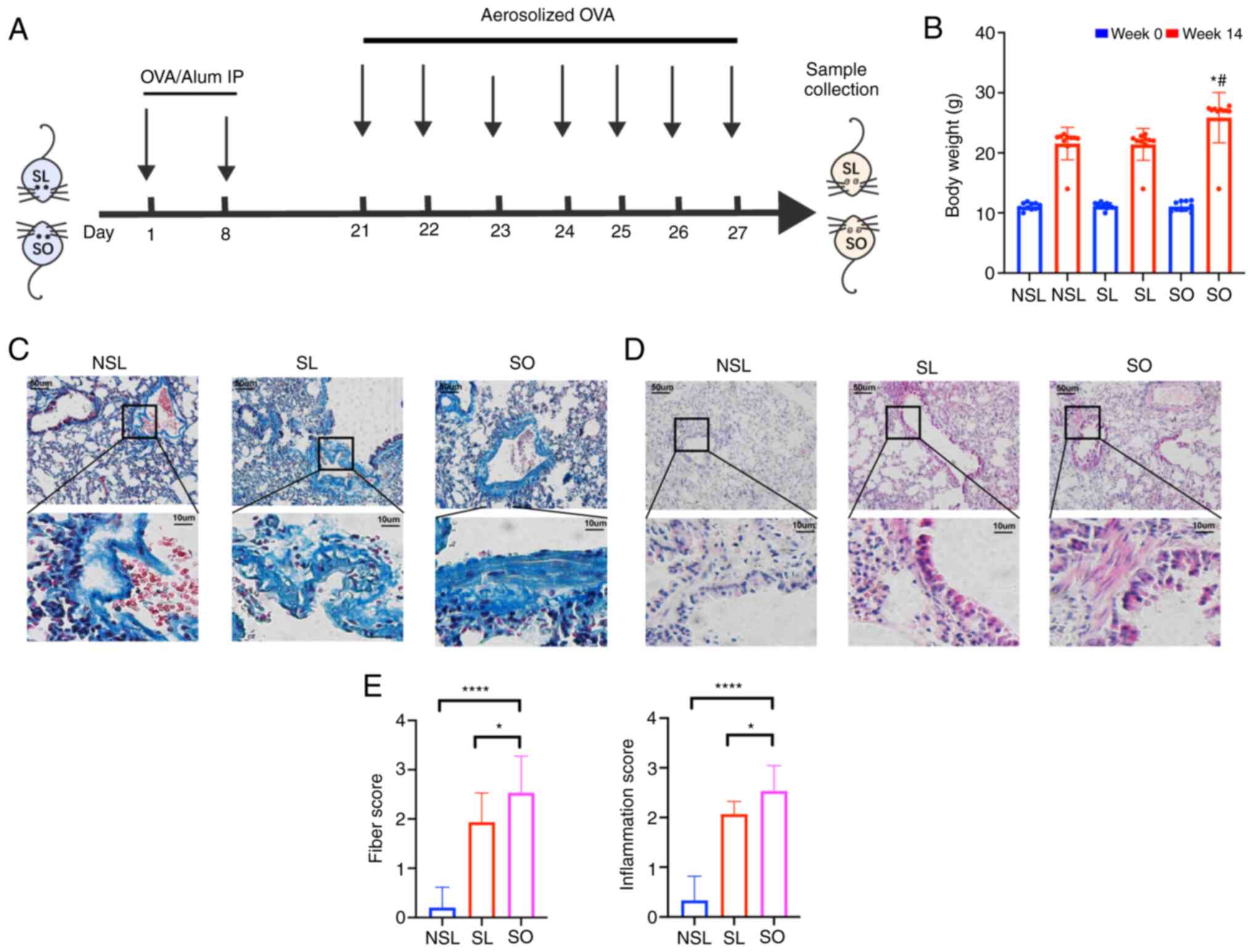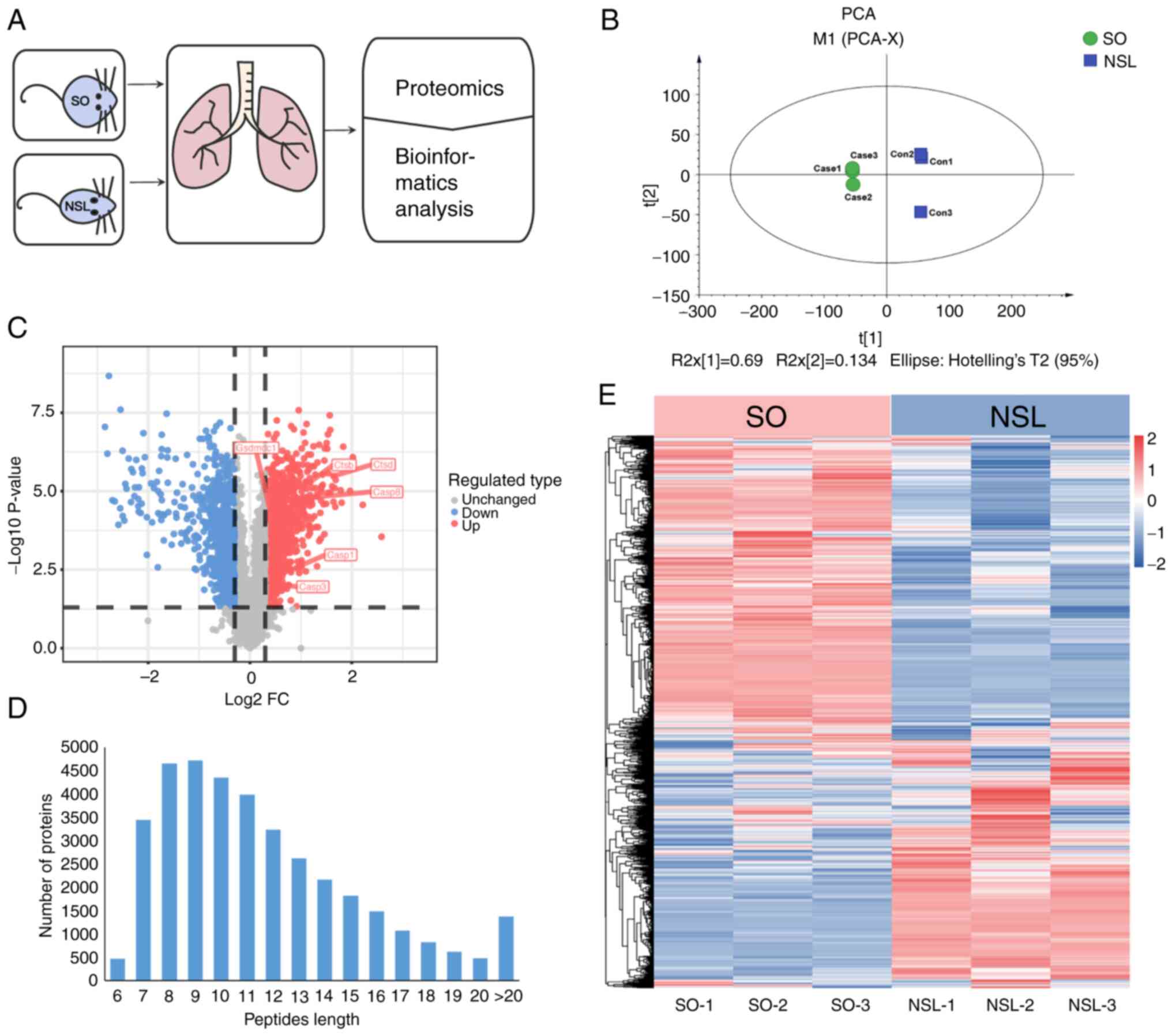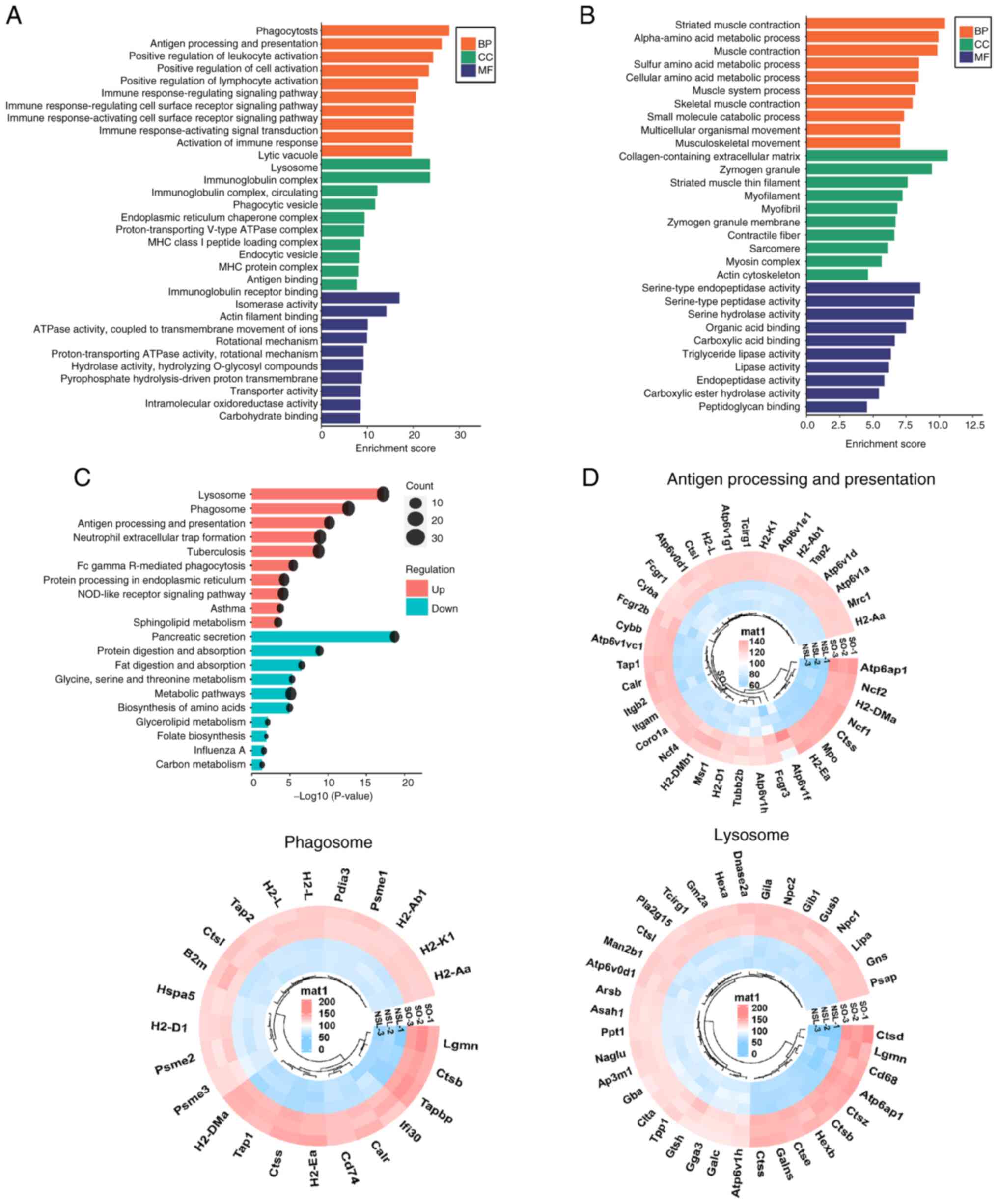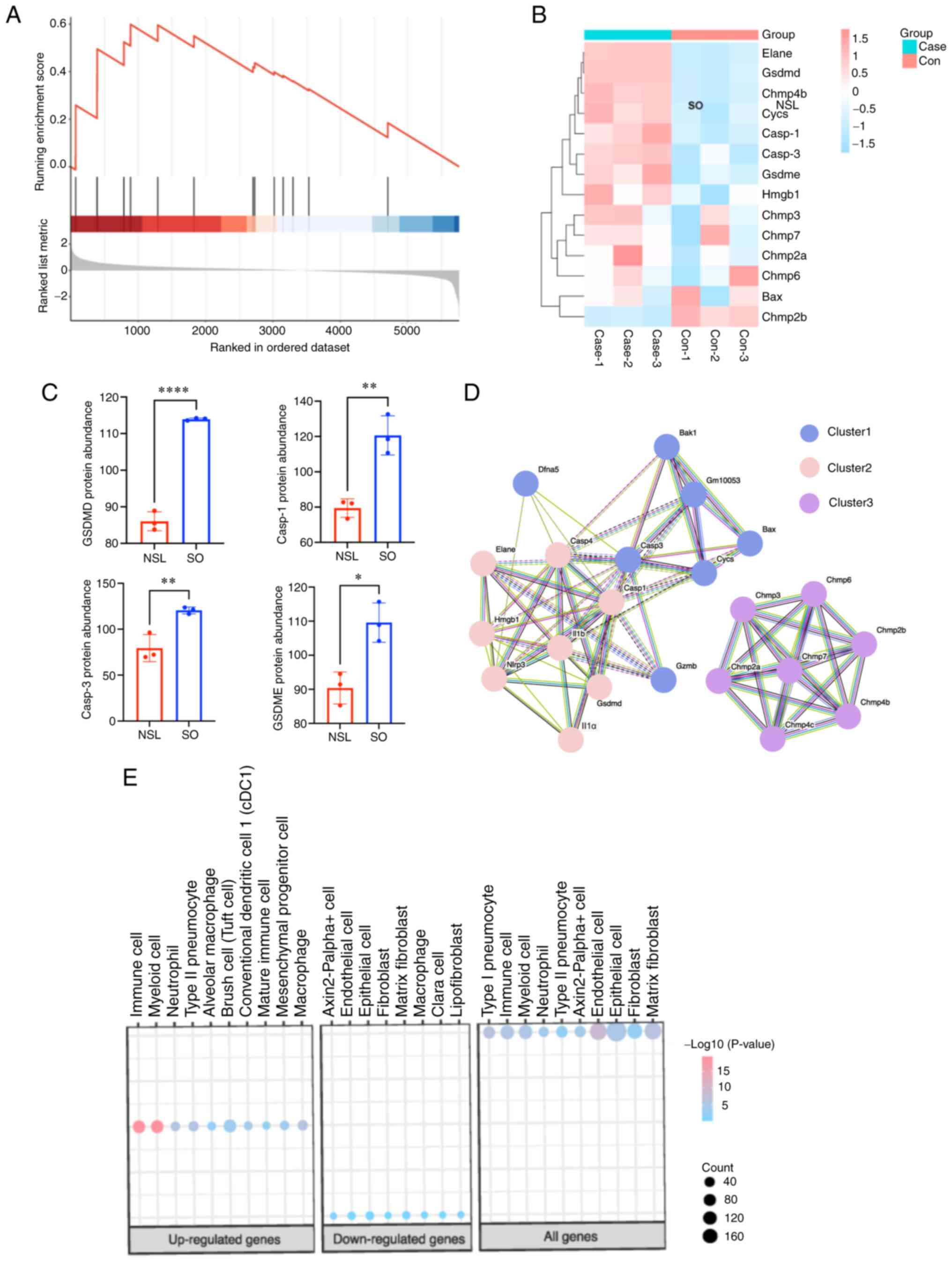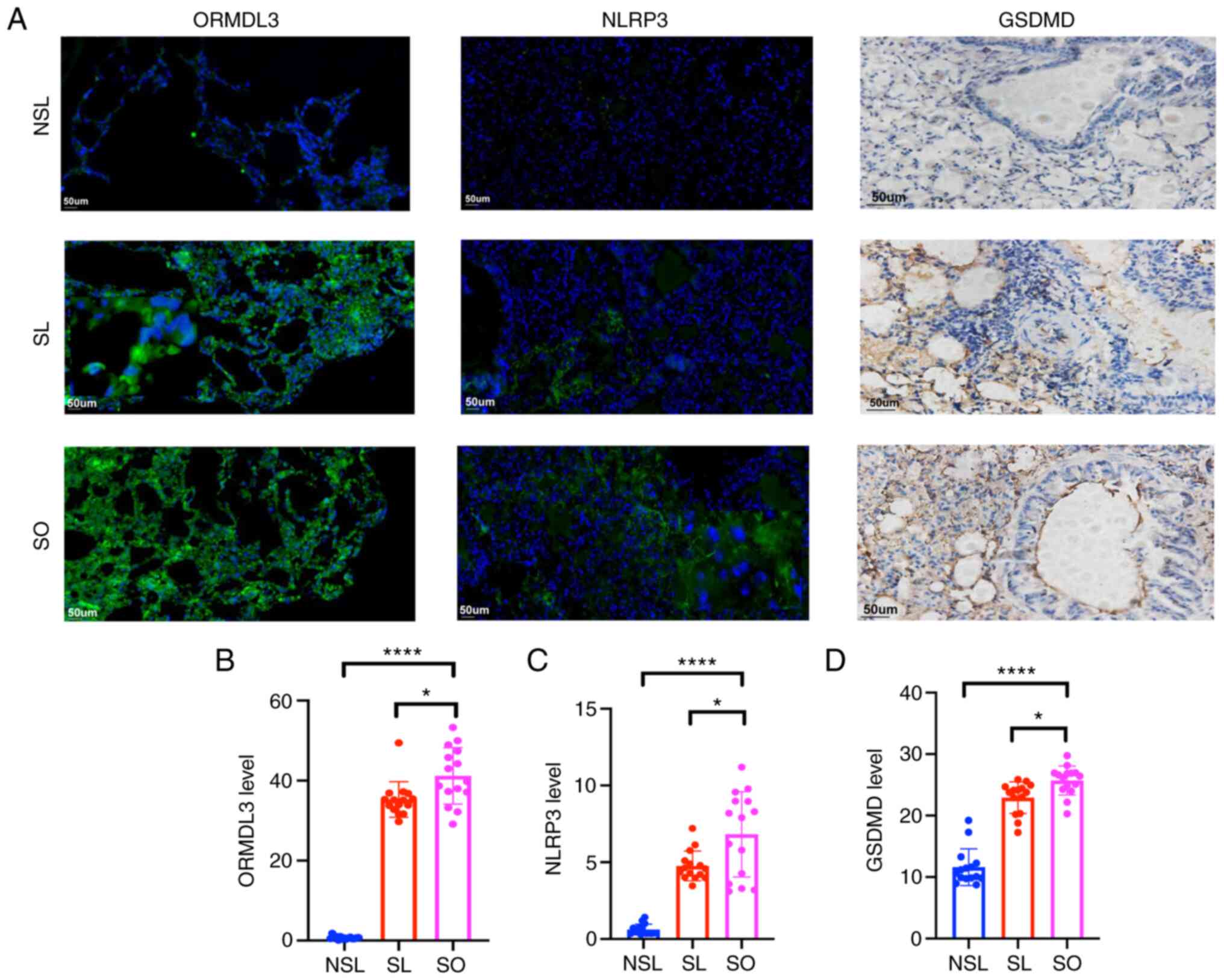|
1
|
Peters U, Dixon AE and Forno E: Obesity
and asthma. J Allergy Clin Immunol. 141:1169–1179. 2018. View Article : Google Scholar : PubMed/NCBI
|
|
2
|
Akinbami LJ and Fryar CD: Current asthma
prevalence by weight status among adults: United States, 2001-2014.
NCHS Data Brief. 239:1–8. 2016.PubMed/NCBI
|
|
3
|
Bantulà M, Roca-Ferrer J, Arismendi E and
Picado C: Asthma and obesity: Two diseases on the rise and bridged
by inflammation. J Clin Med. 10:1692021. View Article : Google Scholar : PubMed/NCBI
|
|
4
|
Pathak MP, Patowary P, Goyary D, Das A and
Chattopadhyay P: β-caryophyllene ameliorated obesity-associated
airway hyperresponsiveness through some non-conventional targets.
Phytomedicine. 89:1536102021. View Article : Google Scholar : PubMed/NCBI
|
|
5
|
Lopes ACR, Zavan B, Corrêa YJC, Vieira TM,
Severs LJ, Oliveira LM and Soncini R: Impact of obesity and
ovariectomy on respiratory function in female mice. Respir Physiol
Neurobiol. 294:1037752021. View Article : Google Scholar : PubMed/NCBI
|
|
6
|
Barton JH, Ireland A, Fitzpatrick M,
Kessinger C, Camp D, Weinman R, McMahon D, Leader JK, Holguin F,
Wenzel SE, et al: Adiposity influences airway wall thickness and
the asthma phenotype of HIV-associated obstructive lung disease: A
cross-sectional study. BMC Pulm Med. 16:1112016. View Article : Google Scholar : PubMed/NCBI
|
|
7
|
Gupta S, Lodha R and Kabra SK: Asthma,
GERD and obesity: Triangle of inflammation. Indian J Pediatr.
85:887–892. 2018. View Article : Google Scholar : PubMed/NCBI
|
|
8
|
Lamkanfi M and Dixit VM: Mechanisms and
functions of inflammasomes. Cell. 157:1013–1022. 2014. View Article : Google Scholar : PubMed/NCBI
|
|
9
|
Cao Y: Angiogenesis and vascular functions
in modulation of obesity, adipose metabolism, and insulin
sensitivity. Cell Metab. 18:478–489. 2013. View Article : Google Scholar : PubMed/NCBI
|
|
10
|
Reddel HK, Bateman ED, Becker A, Boulet
LP, Cruz AA, Drazen JM, Haahtela T, Hurd SS, Inoue H, de Jongste
JC, et al: A summary of the new GINA strategy: A roadmap to asthma
control. Eur Respir J. 46:622–639. 2015. View Article : Google Scholar : PubMed/NCBI
|
|
11
|
Gao W, Li L, Wang Y, Zhang S, Adcock IM,
Barnes PJ, Huang M and Yao X: Bronchial epithelial cells: The key
effector cells in the pathogenesis of chronic obstructive pulmonary
disease? Respirology. 20:722–729. 2015. View Article : Google Scholar : PubMed/NCBI
|
|
12
|
Cohen L, Xueping E, Tarsi J, Ramkumar T,
Horiuchi TK, Cochran R, DeMartino S, Schechtman KB, Hussain I,
Holtzman MJ, et al: Epithelial cell proliferation contributes to
airway remodeling in severe asthma. Am J Respir Crit Care Med.
176:138–1345. 2007. View Article : Google Scholar : PubMed/NCBI
|
|
13
|
Liu J, Fan G, Tao N and Sun T: Role of
pyroptosis in respiratory diseases and its therapeutic potential. J
Inflamm Res. 15:2033–2050. 2022. View Article : Google Scholar : PubMed/NCBI
|
|
14
|
Tsai YM, Chiang KH, Hung JY, Chang WA, Lin
HP, Shieh JM, Chong IW and Hsu YL: Der f1 induces pyroptosis in
human bronchial epithelia via the NLRP3 inflammasome. Int J Mol
Med. 41:757–764. 2018.PubMed/NCBI
|
|
15
|
Zhuang J, Cui H, Zhuang L, Zhai Z, Yang F,
Luo G, He J, Zhao H, Zhao W, He Y and Sun E: Bronchial epithelial
pyroptosis promotes airway inflammation in a murine model of
toluene diisocyanate-induced asthma. Biomed Pharmacother.
125:1099252020. View Article : Google Scholar : PubMed/NCBI
|
|
16
|
Chen X, Xiao Z, Jiang Z, Jiang Y, Li W and
Wang M: Schisandrin B attenuates airway inflammation and airway
remodeling in asthma by inhibiting NLRP3 inflammasome activation
and reducing pyroptosis. Inflammation. 44:2217–2231. 2021.
View Article : Google Scholar : PubMed/NCBI
|
|
17
|
Wang L, Meng J, Wang C, Wang Y, Yang C and
Li Y: Hydrogen sulfide attenuates cigarette smoke-induced
pyroptosis through the TLR4/NF-κB signaling pathway. Int J Mol Med.
49:562022. View Article : Google Scholar : PubMed/NCBI
|
|
18
|
Feng Y, Li M, Yangzhong X, Zhang X, Zu A,
Hou Y, Li L and Sun S: Pyroptosis in inflammation-related
respiratory disease. J Physiol Biochem. 78:721–737. 2022.
View Article : Google Scholar : PubMed/NCBI
|
|
19
|
Moffatt MF, Kabesch M, Liang L, Dixon AL,
Strachan D, Heath S, Depner M, von Berg A, Bufe A, Rietschel E, et
al: Genetic variants regulating ORMDL3 expression contribute to the
risk of childhood asthma. Nature. 448:470–473. 2007. View Article : Google Scholar : PubMed/NCBI
|
|
20
|
Ding Z, Yu F, Sun Y, Jiao N, Shi L, Wan J
and Liu Q: ORMDL3 promotes angiogenesis in chronic asthma through
the ERK1/2/VEGF/MMP-9 pathway. Front Pediatr. 9:7085552021.
View Article : Google Scholar : PubMed/NCBI
|
|
21
|
Song Y, Zan W, Qin L, Han S, Ye L, Wang M,
Jiang B, Fang P, Liu Q, Shao C, et al: Ablation of ORMDL3 impairs
adipose tissue thermogenesis and insulin sensitivity by increasing
ceramide generation. Mol Metab. 56:1014232022. View Article : Google Scholar : PubMed/NCBI
|
|
22
|
Zhang YM: Orosomucoid-like protein 3,
rhinovirus and asthma. World J Crit Care Med. 10:170–182. 2021.
View Article : Google Scholar : PubMed/NCBI
|
|
23
|
James B, Milstien S and Spiegel S: ORMDL3
and allergic asthma: From physiology to pathology. J Allergy Clin
Immunol. 144:634–640. 2019. View Article : Google Scholar : PubMed/NCBI
|
|
24
|
Kim TB, Kim SY, Moon KA, Park CS, Jang MK,
Yun ES, Cho YS, Moon HB and Lee KY: Five-aminoimidazole-
4-carboxamide-1-beta-4-ribofuranoside attenuates poly (I:C)-induced
airway inflammation in a murine model of asthma. Clin Exp Allergy.
37:1709–1719. 2007. View Article : Google Scholar : PubMed/NCBI
|
|
25
|
Wang J, He F, Chen L, Li Q, Jin S, Zheng
H, Lin J, Zhang H, Ma S, Mei J and Yu J: Resveratrol inhibits
pulmonary fibrosis by regulating miR-21 through MAPK/AP-1 pathways.
Biomed Pharmacother. 105:37–44. 2018. View Article : Google Scholar : PubMed/NCBI
|
|
26
|
UniProt Consortium: UniProt: A worldwide
hub of protein knowledge. Nucleic Acids Res. 47:D506–D515. 2019.
View Article : Google Scholar : PubMed/NCBI
|
|
27
|
Metsalu T and Vilo J: ClustVis: A web tool
for visualizing clustering of multivariate data using principal
component analysis and heatmap. Nucleic Acids Res. 43:W566–W570.
2015. View Article : Google Scholar : PubMed/NCBI
|
|
28
|
Cicaloni V, Pecorelli A, Tinti L, Rossi M,
Benedusi M, Cervellati C, Spiga O, Santucci A, Hayek J, Salvini L,
et al: Proteomic profiling reveals mitochondrial alterations in
Rett syndrome. Free Radic Biol Med. 155:37–48. 2020. View Article : Google Scholar : PubMed/NCBI
|
|
29
|
Wang S, Zeng Y, He X, Liu F, Pei P and
Zhang T: Folate-deficiency induced acyl-CoA synthetase short-chain
family member 2 increases lysine crotonylome involved in neural
tube defects. Front Mol Neurosci. 15:10645092022. View Article : Google Scholar : PubMed/NCBI
|
|
30
|
Chen G, Cheng J, Yu H, Huang X, Bao H, Qin
L, Wang L, Song Y, Liu X and Peng A: Quantitative proteomics by
iTRAQ-PRM based reveals the new characterization for gout. Proteome
Sci. 19:122021. View Article : Google Scholar : PubMed/NCBI
|
|
31
|
Yu G, Wang LG, Han Y and He QY:
clusterProfiler: An R package for comparing biological themes among
gene clusters. OMICS. 16:284–287. 2012. View Article : Google Scholar : PubMed/NCBI
|
|
32
|
Qian Z, Cai YD and Li Y: A novel
computational method to predict transcription factor DNA binding
preference. Biochem Biophys Res Commun. 348:1034–1037. 2006.
View Article : Google Scholar : PubMed/NCBI
|
|
33
|
Kanehisa M, Sato Y, Furumichi M, Morishima
K and Tanabe M: New approach for understanding genome variations in
KEGG. Nucleic Acids Res. 47:D590–D595. 2019. View Article : Google Scholar : PubMed/NCBI
|
|
34
|
Zhang X, Lan Y, Xu J, Quan F, Zhao E, Deng
C, Luo T, Xu L, Liao G, Yan M, et al: CellMarker: A manually
curated resource of cell markers in human and mouse. Nucleic Acids
Res. 47:D721–D728. 2019. View Article : Google Scholar : PubMed/NCBI
|
|
35
|
Livak KJ and Schmittgen TD: Analysis of
relative gene expression data using real-time quantitative PCR and
the 2(−Delta Delta C(T)) method. Methods. 25:402–408. 2001.
View Article : Google Scholar : PubMed/NCBI
|
|
36
|
Liu T, Zhou YT, Wang LQ, Li LY, Bao Q,
Tian S, Chen MX, Chen HX, Cui J and Li CW: NOD-like receptor
family, pyrin domain containing 3 (NLRP3) contributes to
inflammation, pyroptosis, and mucin production in human airway
epithelium on rhinovirus infection. J Allergy Clin Immunol.
144:777–787. 2019. View Article : Google Scholar : PubMed/NCBI
|
|
37
|
Yang R, Tan M, Xu J and Zhao X:
Investigating the regulatory role of ORMDL3 in airway barrier
dysfunction using in vivo and in vitro models. Int J
Mol Med. 44:535–548. 2019.PubMed/NCBI
|
|
38
|
de Vasconcelos NM, Van Opdenbosch N, Van
Gorp H, Martín-Pérez R, Zecchin A, Vandenabeele P and Lamkanfi M:
An apoptotic caspase network safeguards cell death induction in
pyroptotic macrophages. Cell Rep. 32:1079592020. View Article : Google Scholar : PubMed/NCBI
|
|
39
|
Kim RY, Pinkerton JW, Essilfie AT,
Robertson AAB, Baines KJ, Brown AC, Mayall JR, Ali MK, Starkey MR,
Hansbro NG, et al: Role for NLRP3 inflammasome-mediated,
IL-1β-dependent responses in severe, steroid-resistant asthma. Am J
Respir Crit Care Med. 196:283–297. 2017. View Article : Google Scholar : PubMed/NCBI
|
|
40
|
Theofani E, Semitekolou M, Samitas K, Mais
A, Galani IE, Triantafyllia V, Lama J, Morianos I, Stavropoulos A,
Jeong SJ, et al: TFEB signaling attenuates NLRP3-driven
inflammatory responses in severe asthma. Allergy. 77:2131–2146.
2022. View Article : Google Scholar : PubMed/NCBI
|
|
41
|
Leszczyńska K, Jakubczyk D and Górska S:
The NLRP3 inflammasome as a new target in respiratory disorders
treatment. Front Immunol. 13:10066542022. View Article : Google Scholar : PubMed/NCBI
|
|
42
|
Sehgal A, Behl T, Kaur I, Singh S, Sharma
N and Aleya L: Targeting NLRP3 inflammasome as a chief instigator
of obesity, contributing to local adipose tissue inflammation and
insulin resistance. Environ Sci Pollut Res Int. 28:43102–43113.
2021. View Article : Google Scholar : PubMed/NCBI
|
|
43
|
Zhang WJ, Chen SJ, Zhou SC, Wu SZ and Wang
H: Inflammasomes and fibrosis. Front Immunol. 12:6431492021.
View Article : Google Scholar : PubMed/NCBI
|
|
44
|
Guan M, Ma H, Fan X, Chen X, Miao M and Wu
H: Dexamethasone alleviate allergic airway inflammation in mice by
inhibiting the activation of NLRP3 inflammasome. Int
Immunopharmacol. 78:1060172020. View Article : Google Scholar : PubMed/NCBI
|
|
45
|
Theofani E, Semitekolou M, Morianos I,
Samitas K and Xanthou G: Targeting NLRP3 inflammasome activation in
severe Asthma. J Clin Med. 8:16152019. View Article : Google Scholar : PubMed/NCBI
|
|
46
|
Chen S, Yao L, Huang P, He Q, Guan H, Luo
Y, Zou Z, Wei S, Peng G, Yan J, et al: Blockade of the
NLRP3/caspase-1 axis ameliorates airway neutrophilic inflammation
in a toluene diisocyanate-induced murine asthma model. Toxicol Sci.
170:462–475. 2019. View Article : Google Scholar : PubMed/NCBI
|
|
47
|
Li Y, Yuan Y, Huang ZX, Chen H, Lan R,
Wang Z, Lai K, Chen H, Chen Z, Zou Z, et al: GSDME-mediated
pyroptosis promotes inflammation and fibrosis in obstructive
nephropathy. Cell Death Differ. 28:2333–2350. 2021. View Article : Google Scholar : PubMed/NCBI
|
|
48
|
Bergsbaken T, Fink SL and Cookson BT:
Pyroptosis: Host cell death and inflammation. Nat Rev Microbiol.
7:99–109. 2009. View Article : Google Scholar : PubMed/NCBI
|
|
49
|
Jiao Y, Zhang T, Zhang C, Ji H, Tong X,
Xia R, Wang W, Ma Z and Shi X: Exosomal miR-30d-5p of neutrophils
induces M1 macrophage polarization and primes macrophage pyroptosis
in sepsis-related acute lung injury. Crit Care. 25:3562021.
View Article : Google Scholar : PubMed/NCBI
|
|
50
|
Liang Q, Cai W, Zhao Y, Xu H, Tang H, Chen
D, Qian F and Sun L: Lycorine ameliorates bleomycin-induced
pulmonary fibrosis via inhibiting NLRP3 inflammasome activation and
pyroptosis. Pharmacol Res. 158:1048842020. View Article : Google Scholar : PubMed/NCBI
|
|
51
|
Songane M, Khair M and Saleh M: An updated
view on the functions of caspases in inflammation and immunity.
Semin Cell Dev Biol. 82:137–149. 2018. View Article : Google Scholar : PubMed/NCBI
|
|
52
|
Aachoui Y, Leaf IA, Hagar JA, Fontana MF,
Campos CG, Zak DE, Tan MH, Cotter PA, Vance RE, Aderem A and Miao
EA: Caspase-11 protects against bacteria that escape the vacuole.
Science. 339:975–978. 2013. View Article : Google Scholar : PubMed/NCBI
|
|
53
|
Miao EA, Rajan JV and Aderem A:
Caspase-1-induced pyroptotic cell death. Immunol Rev. 243:206–214.
2011. View Article : Google Scholar : PubMed/NCBI
|
|
54
|
Debeuf N, Zhakupova A, Steiner R, Van
Gassen S, Deswarte K, Fayazpour F, Van Moorleghem J, Vergote K,
Pavie B, Lemeire K, et al: The ORMDL3 asthma susceptibility gene
regulates systemic ceramide levels without altering key asthma
features in mice. J Allergy Clin Immunol. 144:1648–1659. 2019.
View Article : Google Scholar : PubMed/NCBI
|
|
55
|
Breslow DK, Collins SR, Bodenmiller B,
Aebersold R, Simons K, Shevchenko A, Ejsing CS and Weissman JS: Orm
family proteins mediate sphingolipid homeostasis. Nature.
463:1048–1053. 2010. View Article : Google Scholar : PubMed/NCBI
|
|
56
|
Janneh AH and Ogretmen B: Targeting
sphingolipid metabolism as a therapeutic strategy in cancer
treatment. Cancers (Basel). 14:21832022. View Article : Google Scholar : PubMed/NCBI
|
|
57
|
Heinrich M, Wickel M, Schneider-Brachert
W, Sandberg C, Gahr J, Schwandner R, Weber T, Saftig P, Peters C,
Brunner J, et al: Cathepsin D targeted by acid
sphingomyelinase-derived ceramide. EMBO J. 18:5252–5263. 1999.
View Article : Google Scholar : PubMed/NCBI
|
|
58
|
Bhadra K: A mini review on molecules
inducing caspase-independent cell death: A new route to cancer
therapy. Molecules. 27:64012022. View Article : Google Scholar : PubMed/NCBI
|
|
59
|
Conus S, Pop C, Snipas SJ, Salvesen GS and
Simon HU: Cathepsin D primes caspase-8 activation by multiple
intra-chain proteolysis. J Biol Chem. 287:21142–21151. 2012.
View Article : Google Scholar : PubMed/NCBI
|
|
60
|
Di YQ, Han XL, Kang XL, Wang D, Chen CH,
Wang JX and Zhao XF: Autophagy triggers CTSD (cathepsin D)
maturation and localization inside cells to promote apoptosis.
Autophagy. 17:1170–1192. 2021. View Article : Google Scholar : PubMed/NCBI
|
|
61
|
Orning P, Weng D, Starheim K, Ratner D,
Best Z, Lee B, Brooks A, Xia S, Wu H, Kelliher MA, et al: Pathogen
blockade of TAK1 triggers caspase-8-dependent cleavage of gasdermin
D and cell death. Science. 362:1064–1069. 2018. View Article : Google Scholar : PubMed/NCBI
|
|
62
|
Aghdassi AA, John DS, Sendler M, Weiss FU,
Reinheckel T, Mayerle J and Lerch MM: Cathepsin D regulates
cathepsin B activation and disease severity predominantly in
inflammatory cells during experimental pancreatitis. J Biol Chem.
293:1018–1029. 2018. View Article : Google Scholar : PubMed/NCBI
|
|
63
|
Xing Y, Wang JY, Li MY, Zhang ZH, Jin HL,
Zuo HX, Ma J and Jin X: Convallatoxin inhibits IL-1β production by
suppressing zinc finger protein 91 (ZFP91)-mediated pro-IL-1β
ubiquitination and caspase-8 inflammasome activity. Br J Pharmacol.
179:1887–1907. 2022. View Article : Google Scholar : PubMed/NCBI
|
|
64
|
Song Z, Zou J, Wang M, Chen Z and Wang Q:
A comparative review of pyroptosis in mammals and fish. J Inflamm
Res. 15:2323–2331. 2022. View Article : Google Scholar : PubMed/NCBI
|
|
65
|
Liu C, Yao Q, Hu T, Cai Z, Xie Q, Zhao J,
Yuan Y, Ni J and Wu QQ: Cathepsin B deteriorates diabetic
cardiomyopathy induced by streptozotocin via promoting
NLRP3-mediated pyroptosis. Mol Ther Nucleic Acids. 30:198–207.
2022. View Article : Google Scholar : PubMed/NCBI
|
|
66
|
Chen S, Zhou C, Yu H, Tao L, An Y, Zhang
X, Wang Y, Wang Y and Xiao R: 27-Hydroxycholesterol contributes to
lysosomal membrane permeabilization-mediated pyroptosis in
co-cultured SH-SY5Y cells and C6 cells. Front Mol Neurosci.
12:142019. View Article : Google Scholar : PubMed/NCBI
|



